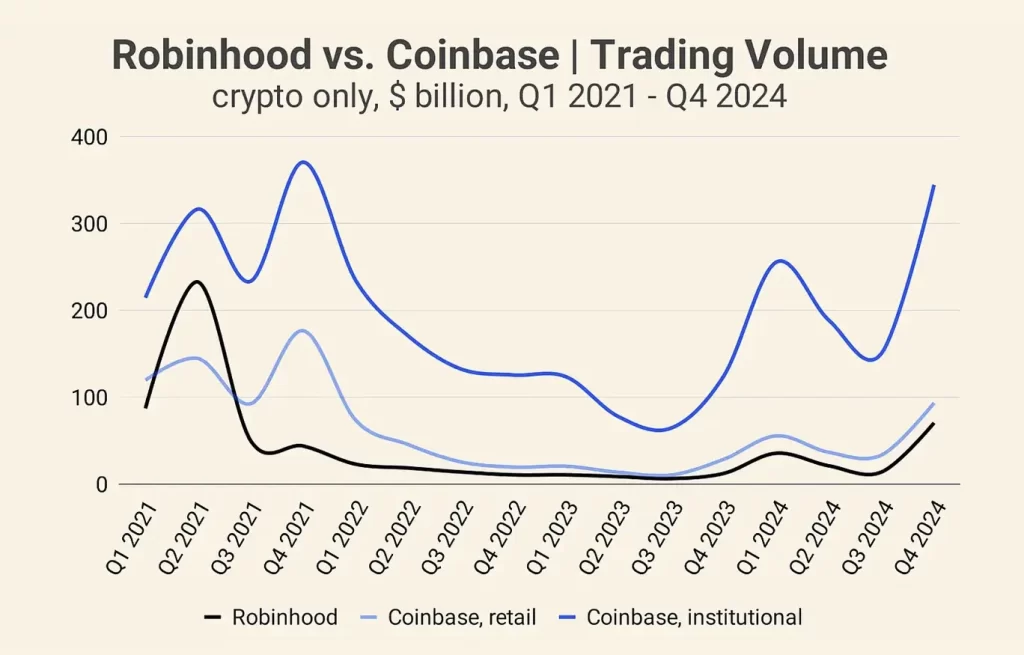Internet brokerage firms are “picking up coins” and crypto exchanges are “breaking the circle”.
Yesterday, Futura Securities announced the launch of bitcoin, ethereum and USDT recharge service, users can transfer crypto assets directly into the account, through the cryptocurrency circle to the stock market funding channel. On the other hand, crypto exchanges are no longer limited to the circle ecosystem, the layout of the payment scene, and some platforms will even include U.S. stocks, gold and other traditional assets into the trading map.
On one side, the brokerage firms are opening up the crypto entrance, and on the other side, the exchanges are integrating resources and expanding payment and compliance pathways. 2025 will be a new starting point for the circulation of crypto assets?
Futura’s Crypto Ambitions
Futura Securities has long been at the top of Hong Kong’s stock app download list, with more than 25 million registered users globally and HK$743.3 billion in client assets. Now, it’s speeding into the fast lane of crypto assets.
As early as 2023, Futura has already started to lay out the crypto track. Its virtual asset platform PantherTrade submitted its application for a virtual asset trading platform license to the Hong Kong Securities and Futura in November of that year, and on August 1, 2024, Futura officially launched its cryptocurrency trading function, opening up spot trading pairs such as BTC and ETH.
Yesterday, Futura went one step further by opening up top-up services for Bitcoin, Ether and USDT. Eligible users can transfer cryptocurrency assets directly to their FUTO accounts and freely switch between Hong Kong and US stocks, ETFs, funds, bonds and virtual assets.
According to the official website of Futura, the minimum thresholds for BTC and ETH top-ups are 0.0002 BTC and 0.001 ETH respectively, while USDT top-ups are only open to professional investors. According to user feedback, the recharge speed of Futu is comparable to that of mainstream exchanges, and the experience is smooth.
“The trend is for brokers to take over the coins.
Futura is not alone in this trend, as traditional brokerage firms have accelerated their embrace of crypto assets, which has become a global trend. In the Hong Kong market, Victory Securities took an earlier step by opening up access to USDT and USDC through the VictoryX APP in May 2024, and proposed this year that it would take “a full eco-service provider of virtual assets” as the core of its development in the next three years.
On the global battlefield, Robinhood, a U.S. brokerage firm, is one of the earliest representatives of “taking over coins”. 2024, its crypto trading volume soared to $143 billion, a year-on-year surge of 259%, close to two-thirds of Coinbase’s retail trading volume. Not content with this, Robinhood plans to launch its crypto service in Singapore by the end of 2025 through the acquisition of Bitstamp, accelerating its entry into the Asia-Pacific market.

The entrants are ramping up and the watchers are catching up. Charles Schwab is expected to open BTC and ETH spot trading within the year, and E*Trade, a subsidiary of Morgan Stanley, also plans to launch crypto services by 2026.
Crypto Platforms “Break the Circle” and Escalate
Not only are traditional brokerage firms moving closer to crypto assets, but crypto platforms are also “breaking the circle” and actively connecting to traditional financial markets.
Bybit has recently revealed that it will go online with traditional asset trading functions such as U.S. stocks, and plans to realize direct trading of U.S. stocks, stock indexes, gold, crude oil and other products on the platform within the year, further expanding the scope of its asset coverage.
At the same time, crypto platforms are accelerating their efforts to open up payment and consumption scenarios, with OKX launching OKX Pay, a “cryptocurrency circle balance treasure” that allows users to turn idle assets into stable income tools; Bitget, Coinbase and other platforms have launched crypto cards, and the crypto cards of OKX and Kraken are in the process of preparation,” said Bybit. Digital assets are being seamlessly integrated into online and offline consumer life in the form of payments.
The layout of “crypto cards” has evolved from point to point, and this move by exchanges not only expands the application boundaries of crypto assets, but also strengthens the ecological closed loop of platforms, enhances user stickiness, and becomes a new business growth curve.
Starting from crypto assets, the crypto platform is reshaping its boundaries by connecting global mainstream investment varieties and payment channels. Crypto KOL Rocky asserted, “There will only be two types of exchanges in the future, one is a comprehensive platform that incorporates RWAs, and the other, traditional exchanges that are still sticking to their pure crypto asset positions.”
Perhaps the next generation of exchanges is being redefined.
Coin-Share Interoperability Has Become Inevitable
The accelerating trend of cryptocurrency-stock interoperability presents both opportunities and challenges. In the future, crypto projects will compete head-to-head with global capital markets for liquidity and attention. At the same time, more investors may begin to evaluate crypto assets from the perspective of U.S. and Hong Kong stocks, and low-quality tokens will be eliminated at an accelerated pace, pushing the market toward high-quality targets. Stablecoin adoption will continue to rise, and the crypto market moves towards the mainstream financial system.
From a global perspective, the regulatory framework is becoming clearer and the compliance threshold is rising, providing a path for traditional brokerage firms and mainstream crypto platforms to grow steadily; on the other hand, IPOs, mergers and acquisitions, and cross-border integrations are becoming normalized, and the fusion of traditional financial capital and crypto infrastructure is reshaping the market landscape.
Crypto assets are crossing ecological silos and moving towards broader circulation and application scenarios.
